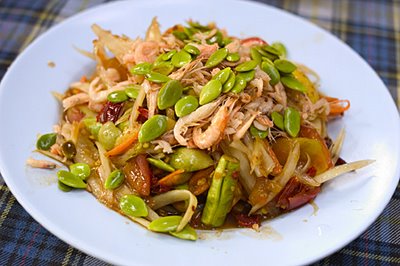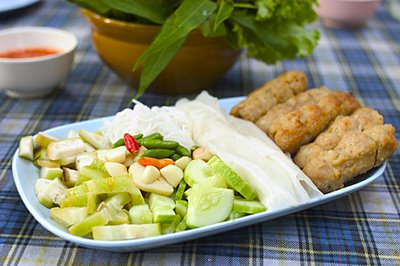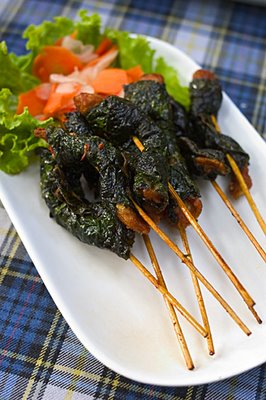Nong Khai is the name of a province in NE Thailand. Lying on banks of the Mekong River, the city of Nong Khai sits directly across from Vientiane, the capial of Laos. Nong Khai is also the name of an Isaan/Vietnamese restaurant very near my home. The place is a real hole in the wall, incorporating insanely crappy service, horribly filthy tablecloths and a kitchen I'm sure I do not want to see. But despite all this, the restaurant serves some of the most interesting regional food in Bangkok, a delicious mix of Vietnamese and NE Thai fare.
Below is by far my favorite dish at the restaurant, as well as possibly one of the tastiest dishes I've come across yet in this country, laap plaa duk:
Laap, as you may already know, is a kind of NE Thai-style "salad" usually consisting of minced meat. Plaa duk means catfish. In this laap the catfish has been grilled, then the meat picked off and minced up along with some hearty freshwater snails. The lot is then mixed up with sliced shallots, green onions, fish sauce, lime and khao khua, ground up roasted sticky rice. It is then served with two vegetables, dill, in the back, known in Thai as phak chee lao, "Lao coriander", and a hard-to-find herb called phak khayaeng. I'm really not sure how to describe the flavor of this herb, which I've virtually only ever come across at this restaurant, but it's sort of bitter and fresh at the same time. The laap itself is spicy, sour, savory, smoky, crunchy, chewy... it really has got everything.
Following close behind the laap plaa duk in terms of interest and flavor is the restaurant's namesake, som tam nong khai:
This som tam differs from papaya salad elsewhere in the use of a few very interesting ingredients. First of all, the small green seeds on the top are called kathin and have a pungent flavor, similar to the southern Thai favorite, sator. Also making this som tam very unusual is the addition of kung ten, literally "dancing shrimp". These are tiny freshwater shrimp that are kept alive until being cooked (or more commonly, eaten raw). They are named for the way they bounce around in the mesh containers they are kept in until being used. And finally this som tam uses a particular kind of small round green and red tomato found in northern isaan and northern Thailand known as makhuea som. These tomatoes have a wonderfully crispy texture, and a slightly sour/sweet flavor. All in all a very unusual and delicious variation on the already delicious papaya salad.
Next was deep-fried pork belly served with thin rice noodles and crispy fried shallots, a dish of Vietnamese origin, I do believe.
Pretty damn good, but crunching through deep-fried pork fat is a guilty pleasure I'd rather not take part in too often.
One of the most popular dishes at the restaurant is a Vietnamese dish called naem nueang:
This is grilled pork "sausages" served with a variety of condiments and rice paper wrappers and a fat bowl of fresh herbs. You take a lettuce leaf, top it with some herbs, top this with a piece of rice paper, a chunk of sausage, a chunk of garlic, cucumber, chilies, unripe banana or starfruit, and finish it off with a generous dollop of the requisite sweet/sour peanut sauce. The final step involves rolling this "package" up and stuffing it in your greedy gob. Yes, I know, a lot of work just to eat, but it's worth it.
My companions ordered this dish, pork skewers wrapped in bai cha phluu (wild tea leaf) and "grilled":
I write "grilled" rather than grilled because the menu says they are grilled when in fact they are deep-fried. A brilliant idea for a dish, but definately not something that should be deep-fried; the greasy skewers alone are enough to make me not want to eat it.
















